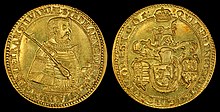Stephen Bocskai
He spent his youth in the court of the Holy Roman Emperor, Maximilian, who was also the ruler of Royal Hungary (the western and northern regions of the medieval kingdom).After his secret correspondence with the Grand Vizier, Lala Mehmed Pasha, was captured in October 1605, Bocskai openly rebelled against Rudolph.He expanded his authority over the Partium, Transylvania proper, and nearby counties with the support of the local noblemen and burghers who had also been stirred up by Rudolph's tyrannical acts.[21][22] As the youngest member of the regency council, Bocskai had little chance of influencing the government, then dominated by Sándor Kendi and Farkas Kovacsóczy.[22] Bocskai and Dénes Csáky decided to go to Kraków to convince Stephen Báthory to make their ally, János Ghyczy, the sole regent for Sigismund.[41] The Ottoman Sultan, Murad III, ordered the Grand Vizier, Koca Sinan Pasha, to invade Royal Hungary in August 1593.[45][46] Sigismund did not abandon his plan to fight against the Ottomans, but only Bocskai and Ferenc Geszthy, who was the captain of Déva (now Deva in Romania), supported him in the royal council.[46] The Holy Roman Emperor, Rudolph (who was also the king of Hungary), acknowledged the independence of Transylvania and promised his niece, Maria Christina, to Sigismund Báthory.[62][63] Bocskai accompanied Maria Christina from Kassa (now Košice in Slovakia) to Gyulafehérvár (present-day Alba Iulia in Romania) in July.[64] Sigismund Báthory made György Borbély Ban of Karánsebes (now Caransebeș in Romania), ordering him to invade the nearby Ottoman territories.[70][67] To be able to provide military assistance to Michael of Wallachia, Sigismund Báthory promised the Székely commoners, who had earlier been reduced to serfdom, to restore their liberties if they joined his campaign on 15 September.[67] After Michael the Brave and Sigismund's other vassal, Ștefan Răzvan of Moldavia, joined the campaign, their united troops laid siege to Târgoviște on 16 October.[67] Two days later, Bocskai personally led the decisive attack against the fortress, forcing the Ottoman soldiers to abandon it and try to break through the besiegers.[70][72] By the time Sigismund's army reached the Danube, most Ottoman soldiers had crossed the river, but those who had stayed behind in Wallachia were massacred on 29 October.[82][84] Rudolph appointed three commissioners (István Szuhay, Bartholomeus Pezzen, and Miklós Istvánffy) to administer Transylvania until the arrival of his governor, Maximilian III, Archduke of Austria.[88] Bocskai was again made the supreme commander of the Transylvanian army,[66] but his former deputy, György Király, did not obey him and allowed Rudolph's troops to take possession of Várad.[96] After Bocskai ignored the prince's summons, his estates were confiscated in October, but this order could only be executed in Transylvania proper because the Partium was controlled by the emperor's supporters.[97] Bocskai was planning to invade Transylvania, but Michael of Wallachia (whom Andrew wanted to replace with one of his brothers) was quicker and broke into the principality.[114] He again settled in Szentjobb and made several attempts to secure the restoration of his confiscated Transylvanian estates, but Basta sharply opposed his plan.[116][117] After Giacomo Barbiano di Belgiojoso, the captain of Kassa, confiscated the St. Elisabeth Cathedral from the Lutherans and gave it to the Catholics in early 1604, Rudolph prohibited the Diet of Hungary from discussing religious issues.[124] On his way back from Transylvania, on 20 September he learnt that Hajdús had seized a letter about his alleged correspondence with the Grand Vizier, Lala Mehmed Pasha, from Gabriel Bethlen.[127] Actually, he ordered his castellans to make preparations for resistance, but one of them revealed Bocskai's plans to Cipriano Concini, the deputy captain of Várad.[136] Bocskai made the young Calvinist lords, Bálint Drugeth and Ferenc Mágocsy, commanders of his army, and the Catholic nobleman, Mihály Káthay, his chancellor.[139] Gabriel Bethlen came to Kassa on 20 November, accompanied by Lala Mehmed Pasha's envoy, who handed the sultan's ahidnâme (or charter) to Bocskai, which styled him prince of Transylvania.[140][142] Basta defeated Bocskai near Edelény on 27 November, but he could not capture Kassa and withdrew to Eperjes (now Prešov in Slovakia) in early December.[145] He made an alliance with Ieremia Movilă, Voivode of Moldavia, and promised the Székelys that he would restore their liberties, enabling him to secure his rule in Transylvania.[142][136][146] Bocskai sent proclamations, entitled Querelae Hungariae (Complaints of Hungary), to the royal courts of Europe in March, accusing Rudolph of tyranny and listing the monarch's unlawful acts that had caused the uprising.[119] Bocskai's army captured Nagyszombat (now Trnava in Slovakia), Sümeg, Szombathely, Veszprém, and other towns in Transdanubia and also pillaged Lower Austria, Moravia, and Silesia in May.[148][155] Bocskai's commander, Bálint Drugeth, prevented his Ottoman allies from entering Érsekújvár (now Nové Zámky in Slovakia) when he forced the defenders of the town to give in on 17 October.[182] For instance, Géza Pálffy emphasizes, most Hungarian noblemen remained loyal to the Habsburg monarch, thus Bocskai's uprising should be described as a civil war.










personal namePrince of TransylvaniaSigismund RákócziEastern Hungarian KingdomRoyal HungarySt. Michael's CathedralTransylvaniaAlba IuliaReformedHungarianSlovakHungarian noble familyeastern regions of the medieval Kingdom of HungaryPrincipality of TransylvaniaHoly Roman EmperorMaximilianunderageSigismund BáthoryDiet of TransylvaniaOradeaHoly LeagueWallachiaBattle of GiurgiuMaximilian IIRudolphAndrew BáthoryMichael the BraveLala Mehmed PashaHajdúsPartiumcountiesTreaty of ViennaHabsburg monarchyZemplén CountiesIstván DobóVoivode of TransylvaniaFerdinand IKing of HungaryIsabella Jagielloneastern part of the Kingdom of HungaryJohn Sigismund ZápolyaCluj-NapocaKismarjaStephen BáthoryKing of PolandChristopher BáthoryReformationSigismundSándor KendiFarkas KovacsóczyJános GhyczyNagykerekiBalthasar BáthoryBáthory familyBattle of Giurgiu (1595)Joris HoefnagelJesuitispánOttoman SultanMurad IIIGrand VizierKoca Sinan PashaCrimean TatarsThree Nations of TransylvaniaRemetea ChioaruluiFerenc NádasdyKraszna CountiesBrâncoveneștiSâniobȘinteuplenipotentiaryMaria ChristinaKošiceBan of KaránsebesMaros (Mureș) RiverTârgoviștebeylerbeySzékelyȘtefan RăzvanMoldaviaGiurgiuimpalementSzékely LandBloody CarnivalChancellor of TransylvaniaIstván JósikaMiklós IstvánffyMaximilian III, Archduke of AustriaSebeșengravingAegidius SadelerGiorgio BastaBattle of SellenberkhajdukSt. Elisabeth CathedralGabriel BethlenBocskai UprisingÁlmosdUpper HungaryBálint DrugethMihály KáthayOžďanyahidnâmeEdelényPrešovUnitarianJános PetkiIeremia MovilăVoivode of MoldaviaMiercurea NirajuluiTransylvanian SaxonsPressburgSzerencsTransdanubianSublime PorteTrnavaSümegSzombathelyVeszprémLower AustriaMoraviaSilesiaMichael WeissBrașovSighișoaraMediaș